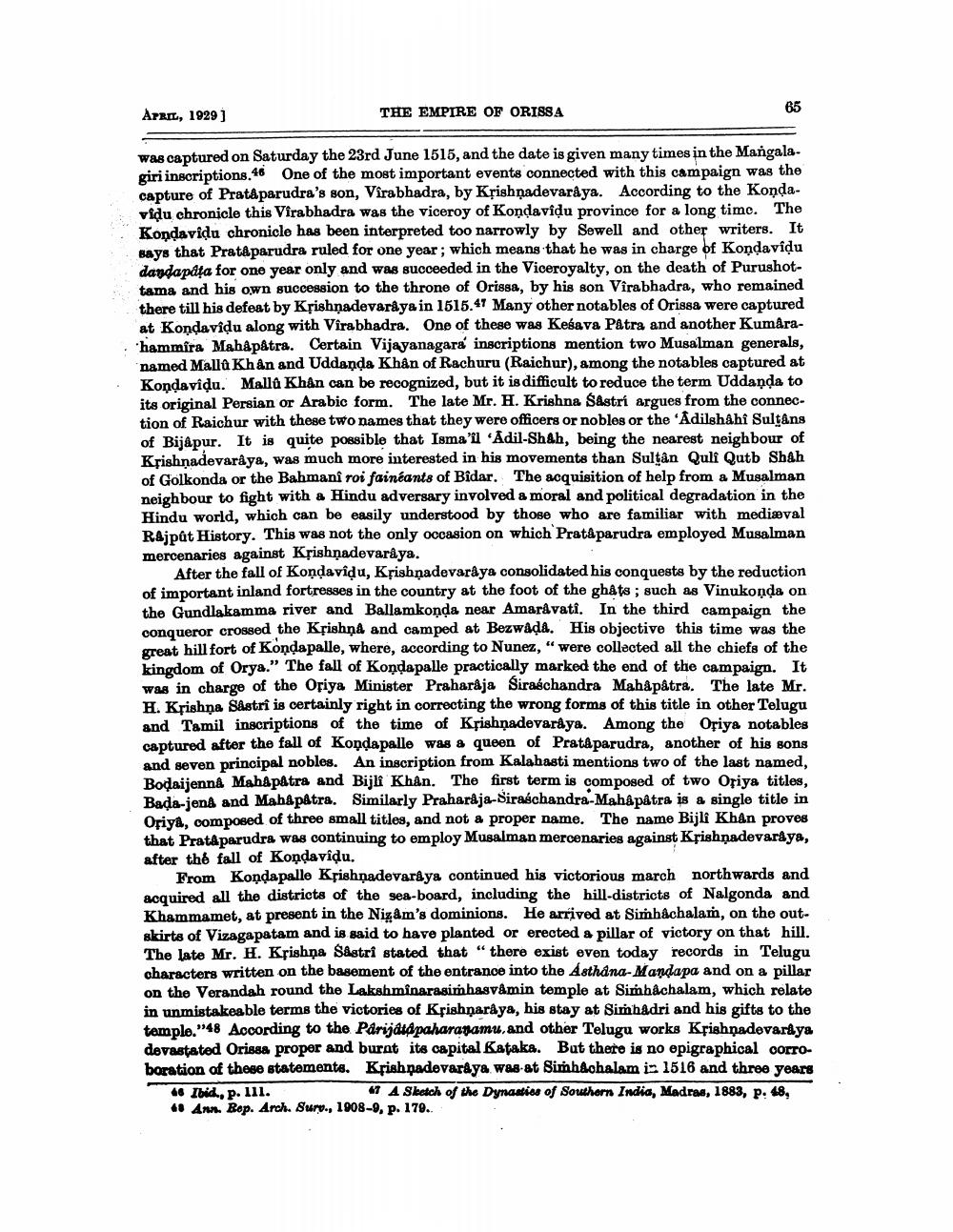________________
APRIL, 1929]
THE EMPIRE OF ORISSA
65
was captured on Saturday the 23rd June 1515, and the date is given many times in the Mangala. giri inscriptions.46 One of the most important events connected with this campaign was the capture of Prataparudra's son, Virabhadra, by Krishnadevaraya. According to the Kondavidu chronicle this Virabhadra was the viceroy of Kondaviḍu province for a long time. The Kondavidu chronicle has been interpreted too narrowly by Sewell and other writers. It says that Prataparudra ruled for one year; which means that he was in charge of Kondavidu dandapata for one year only and was succeeded in the Viceroyalty, on the death of Purushottama and his own succession to the throne of Orissa, by his son Virabhadra, who remained there till his defeat by Krishnadevaraya in 1515.47 Many other notables of Orissa were captured at Kondavidu along with Virabhadra. One of these was Kesava Pâtra and another Kumarahammira Mahapatra. Certain Vijayanagara inscriptions mention two Musalman generals, named Mallu Khân and Uddanda Khân of Rachuru (Raichur), among the notables captured at Kondavidu. Mallû Khân can be recognized, but it is difficult to reduce the term Uddanda to its original Persian or Arabic form. The late Mr. H. Krishna Sastri argues from the connection of Raichur with these two names that they were officers or nobles or the 'Adilshâhî Sulţâns of Bijapur. It is quite possible that Isma'il 'Adil-Shah, being the nearest neighbour of Krishnadevaraya, was much more interested in his movements than Sultan Quli Qutb Shah of Golkonda or the Bahmanî roi fainéants of Bidar. The acquisition of help from a Musalman neighbour to fight with a Hindu adversary involved a moral and political degradation in the Hindu world, which can be easily understood by those who are familiar with mediaval Rajpût History. This was not the only occasion on which Pratâ parudra employed Musalman mercenaries against Krishnadevaraya.
After the fall of Kondavidu, Krishnadevaraya consolidated his conquests by the reduction of important inland fortresses in the country at the foot of the ghats; such as Vinukonda on the Gundlakamma river and Ballamkonda near Amaravatî. In the third campaign the conqueror crossed the Krishna and camped at Bezwâda. His objective this time was the great hill fort of Kondapalle, where, according to Nunez, "were collected all the chiefs of the kingdom of Orya." The fall of Kondapalle practically marked the end of the campaign. It was in charge of the Oriya Minister Praharaja Siraśchandra Mahâpâtra. The late Mr. H. Krishna Săstrî is certainly right in correcting the wrong forms of this title in other Telugu and Tamil inscriptions of the time of Krishnadevaraya. Among the Oriya notables captured after the fall of Kondapalle was a queen of Pratâ parudra, another of his sons and seven principal nobles. An inscription from Kalahasti mentions two of the last named, Boḍaijenna Mahapatra and Bijli Khan. The first term is composed of two Oriya titles, Bada-jena and Mahapatra. Similarly Praharaja-Siraéchandra-Mahâpâtra is a single title in Oriya, composed of three small titles, and not a proper name. The name Bijlî Khân proves that Prataparudra was continuing to employ Musalman mercenaries against Krishnadevaraya, after the fall of Kondaviḍu.
From Kondapalle Krishnadevaraya continued his victorious march northwards and acquired all the districts of the sea-board, including the hill-districts of Nalgonda and Khammamet, at present in the Nizam's dominions. He arrived at Simhachalam, on the outskirts of Vizagapatam and is said to have planted or erected a pillar of victory on that hill. The late Mr. H. Krishna Sâstrî stated that "there exist even today records in Telugu characters written on the basement of the entrance into the Asthana-Mandapa and on a pillar on the Verandah round the Lakshminarasimhasvamin temple at Simhachalam, which relate in unmistakeable terms the victories of Krishnaraya, his stay at Simhadri and his gifts to the temple."48 According to the Parijatapaharanamu, and other Telugu works Krishnadevaraya devastated Orissa proper and burnt its capital Kataka. But there is no epigraphical corroboration of these statements. Krishnadevaraya was at Simhachalam in 1516 and three years 46 Ibid., p. 111. 47 A Sketch of the Dynasties of Southern India, Madras, 1883, p. 48, 48 Ann. Rep. Arch. Surv., 1908-9, p. 179..




